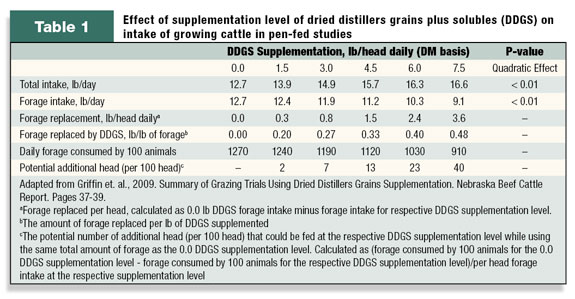Generally speaking, there are two reasons to supplement a forage program:
To address deficiencies in the grazing system, be they energy, protein, vitamin or mineral deficiencies; and to increase production from the land, which is generally accomplished through energy supplementation to increase carrying capacity of the land.
Obviously, the first consideration in supplementation programs is addressing any nutrient deficiencies that may exist in the grazing system in order to maximize production from the forage base.
If the animal’s requirement is more than what the forage will supply, then supplementation is needed to optimize production.
Meeting the nutrient requirements for beef cattle is more of an art than a science, because those requirements are dependent on several variables, and the precise levels at which all subclinical manifestations of deficiencies disappear is generally not known to the degree that some believe.
Therefore, having a good estimate of forage composition for those nutrients and cattle intake is less important in the scenario where the goal is simply to address nutrient deficiencies, because the target tends to be somewhat broad.
Moreover, several producers see value in spending a little bit of money on vitamin and mineral supplements that may provide nutrients in excess as a form of “insurance” against the reductions in animal health and performance that can occur when deficiencies exist.
However, this is all under the assumption that the animal’s energy requirement is met for the production goal, which is heavily dependent on forage composition and intake.
When considering supplementation programs to increase productivity of a land base independent of nutrient deficiencies, estimates of intake and quality of forage become much more important.
This is due mostly to the importance of these estimates in determining the potential economic return of the supplementation program.
Feed intake of cattle is controlled by one of two mechanisms: Physical capacity of the rumen or some energy consumption trigger.
Assuming forage supply of a grazing operation is adequate, supplemental energy feeds should have an energy value greater than the forage they are replacing in order to increase production.
When higher-energy feeds are supplemented, not only will per-animal production increase, but intake of forage will generally decrease, assuming all other nutrient requirements are met without supplementation.
This concept is illustrated by an analysis put together by the University of Nebraska looking at the average daily gain responses to and forage replacement rates of dried distillers grains plus solubles (DDGS) supplementation of growing cattle fed forage-based diets (Table 1).

As DDGS supplementation level increased, average daily gain increased quadratically. This would be expected because the DDGS has a greater energy value than the forage.
Some of the response may have been due to meeting protein deficiencies at the lower levels of supplementation, but overall the improvement in average daily gain appears to have been a response to the supplemental energy provided by the DDGS.
Another important take-home message from the analysis is found in the forage intake data from cattle in pen-fed studies, where, as the level of supplemental DDGS increased, the per-head forage intake decreased quadratically.
The reader should be cautioned that these data are taken from studies where growing cattle were fed harvested forages in a pen and don’t apply directly to grazing situations, but conceptually the trend should hold in grazing cattle provided supplemental energy.
When one considers a set forage base, the potential amount of forage the land is able to produce is a constant value.
While stocking rates can have an impact on forage production, providing supplemental energy will decrease per-head forage intake and increase the overall carrying capacity of the land.
Therefore, when supplemental energy is provided to grazing animals, the stocking rate can be increased in a manner that does not negatively impact pasture conditions.
When we look at the pen data from the analysis mentioned above, we can see in Table 1 that we can increase the number of head fed a given amount of forage when they are supplemented with DDGS.
In order to realize the full economic value of a supplementation program, this increase in the carrying capacity of forage base needs to be utilized.
The trick for the producer is to find credible data for a given forage, region and animal type or to develop a simple system to evaluate the effect of supplemental energy on per-head forage intake. ![]()

Mark Corrigan
Beef Technical
Services Manager
Lallemand Animal Nutrition
mcorrigan@lallemand.com







